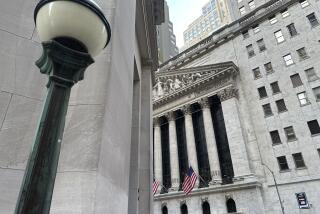From the Blogs
- Share via
Only a handful of pet funeral homes exist around the country, but that’s about to soon change.
This month, Coleen Ellis, owner of Pet Angel Memorial Center in Carmel, Ind., will begin franchising her pet funeral home business and plans to open 250 to 300 locations nationwide over the next seven years.
Ellis believes that pets, who are treated as family members by most owners, should receive the same quality after-care as humans.
L.A. UNLEASED
Funerals for pets: a growth industry
Her service includes picking up the bodies of deceased pets from veterinary hospitals, where they’re immediately wrapped in blankets and put into caskets. Back at the funeral home, staff members help guide grieving owners through a vast array of memorial and burial options. Most clients opt for “visitations” where last respects are paid in the chapel or family room, Ellis says.
During the private ceremonies, an urn with the pet’s ashes is usually displayed so owners as well as friends, family and surviving pets can pay their final respects.
About two visitations take place daily for a variety of furry and finned creatures including dogs, cats, rabbits, goldfish, rats and lizards.
Ellis says she started the country’s first pet funeral home four years ago after the death of her dog Mico, a schnauzer mix.
-- Maryann MottAll things animal in Southern California and beyond.
For more L.A. Unleashed, go to www.latimes.com/unleashed
BOOSTER SHOTS
Study looks at work and ADHD
A study released last week on the work habits of people with attention deficit hyperactivity disorder stirred up considerable angst among people with ADHD and those who treat them, according to a sampling of mental health blogs. The study, published online in Occupational and Environmental Medicine, found that workers with ADHD do 22 days less work per year than people who do not have the disorder. The research, which surveyed more than 7,000 employed people ages 18 to 44, was conducted by a World Health Organization research consortium based at Harvard Medical School.
The paper found that 3.5% of workers have ADHD but noted that many adults with the condition weren’t aware of it. The lead author of the paper said that employers might want to implement targeted workplace screening to assess ADHD and offer treatment to some employees. That suggestion raises all kinds of uncomfortable issues, such as the potential for discrimination against workers with ADHD and the specter of some kind of forced treatment to keep one’s job -- not to mention health privacy issues.
Besides, says the blogger, Furious Seasons, who among us doesn’t have good work days and bad? He writes:
“Isn’t America already the most [or second most] productive country in the world? Don’t Americans already work more hours per week than just about any people on Earth? We’re already working our butts off, the price of everything is going up dramatically, our wages are largely stagnant. Why do we need to perform even more? Who is this kind of policy wonk talk really serving? Workers? Eli Lilly? Harvard? Boeing?”
-- Shari RoanOddities, musings, and some news from the world of health
For more, go to latimes.com/boostershots
MONEY & CO.
Wall Street: How much to worry?
Investors who bought U.S. Treasury bonds in the last few weeks are having a bad case of buyer’s remorse: Yields in that market keep rising and last week crossed some important thresholds.
The yield on the 10-year T-note, for example, has jumped above 4% for the first time since the beginning of January. It reached 4.08% on Thursday, up from 3.33% in late March. That’s a big move for a 10-week span.
Wall Street, however, isn’t quite sure how worried it should be about the turnabout in bond rates. Some part of the rebound is a welcome return to normalcy after the financial-system-meltdown scare of mid-March (the Bear Stearns debacle), when investors rushed into Treasuries for safety.
But there also is a gnawing fear among bond market pros that the Treasury market is playing the canary-in -the-coal-mine role on inflation: meaning, investors are demanding higher fixed yields on Treasuries to compensate for their concern that inflation will continue to rise and ultimately force the Federal Reserve to begin tightening credit.
Given $130-a-barrel oil, “I think the notion of inflation taking root now is a global concern,” said T.J. Marta, fixed-income strategist at RBC Capital Markets in New York.
Global indeed: Government bond yields in Europe and Japan also have shot up in recent weeks. The 10-year German government bond yield hit 4.43% on Thursday, the highest since last fall.
At the same time, though, yields on riskier bonds -- such as U.S. corporate junk issues -- rose only modestly in May. The yield on an index of 100 junk issues tracked by KDP Investment Advisors was 9.30% on Thursday, up from 9.12% on May 1 and down from 10.16% in mid-March.
That suggests that some investors who have exited Treasuries have moved their money into riskier securities.
That’s exactly what the Fed has been hoping to see, as a sign of faith in the wobbly economy.
If the core inflation rate (the one that excludes food and energy) begins to bust out from the current 2% range, Treasury yields at these levels would look mighty paltry. That could mean we ain’t seen nothin’ yet in terms of how quickly investors might seek to unload Uncle Sam’s paper.
-- Tom PetrunoTracking the market and economic trends that shape your finances
For more, go to latimes.com/money_co
More to Read
Sign up for Essential California
The most important California stories and recommendations in your inbox every morning.
You may occasionally receive promotional content from the Los Angeles Times.













